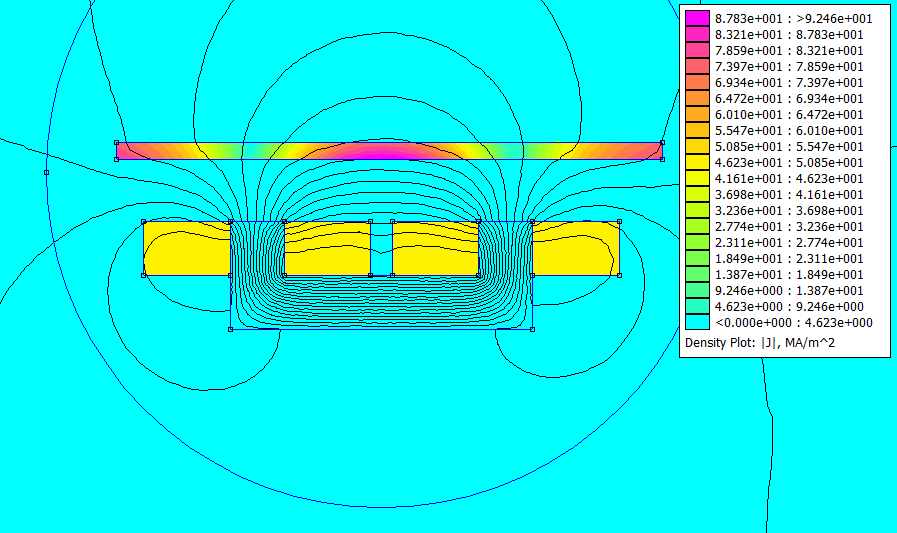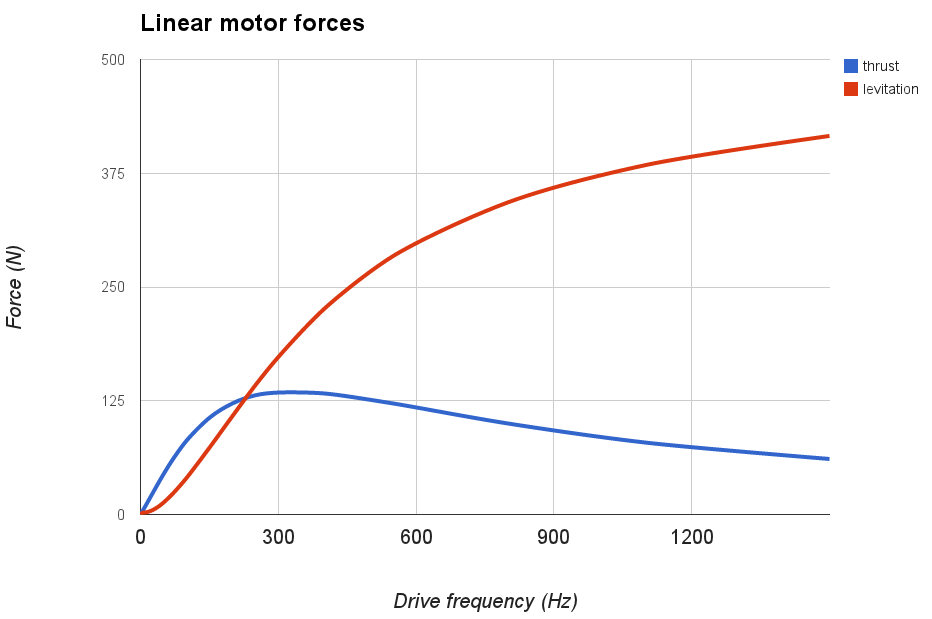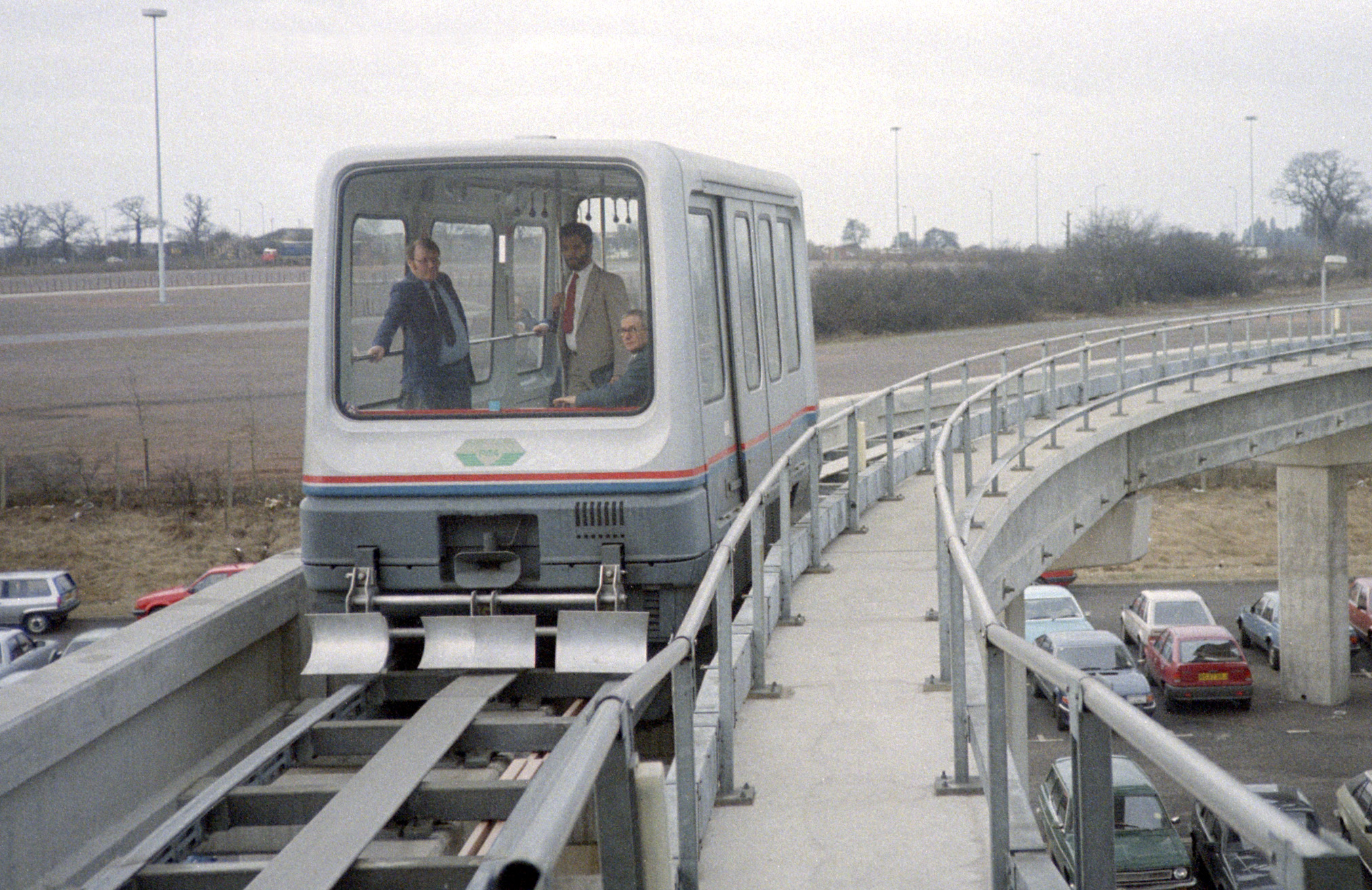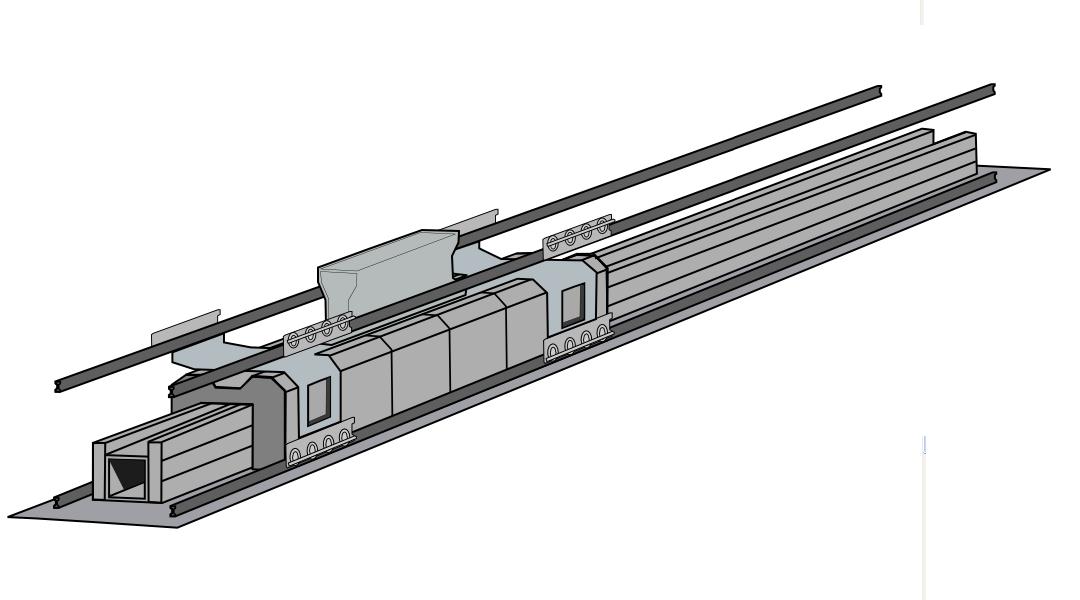linear induction motor on:
[Wikipedia]
[Google]
[Amazon]
 A linear induction motor (LIM) is an
A linear induction motor (LIM) is an
 In a single-sided version, the magnetic field can create repulsion forces that push the conductor away from the stator, levitating it and carrying it along the direction of the moving magnetic field. Laithwaite called the later versions a magnetic river. These versions of the linear induction motor use a principle called ''transverse flux'' where two opposite poles are placed side by side. This permits very long poles to be used, and thus permits high speed and efficiency.
In a single-sided version, the magnetic field can create repulsion forces that push the conductor away from the stator, levitating it and carrying it along the direction of the moving magnetic field. Laithwaite called the later versions a magnetic river. These versions of the linear induction motor use a principle called ''transverse flux'' where two opposite poles are placed side by side. This permits very long poles to be used, and thus permits high speed and efficiency.
/ref> with coils laid into the slots, with each phase giving an alternating polarity so that the different phases physically overlap. The secondary is frequently a sheet of aluminium, often with an iron backing plate. Some LIMs are double sided with one primary on each side of the secondary, and, in this case, no iron backing is needed. Two types of linear motor exist: a ''short primary'', where the coils are truncated shorter than the secondary, and a ''short secondary'', where the conductive plate is smaller. Short secondary LIMs are often wound as parallel connections between coils of the same phase, whereas short primaries are usually wound in series. The primaries of transverse flux LIMs have a series of twin poles lying transversely side-by-side with opposite winding directions. These poles are typically made either with a suitably cut laminated backing plate or a series of transverse U-cores.
 In this electric motor design, the force is produced by a linearly moving
In this electric motor design, the force is produced by a linearly moving
 The drive generated by linear induction motors is somewhat similar to conventional induction motors; the drive forces show a roughly similar characteristic shape relative to slip, albeit modulated by end effects.Force Analysis of Linear Induction Motor for Magnetic Levitation System 14th International Power Electronics and Motion Control Conference, EPE-PEMC 2010
Equations exist for calculating the thrust of a motor.
The drive generated by linear induction motors is somewhat similar to conventional induction motors; the drive forces show a roughly similar characteristic shape relative to slip, albeit modulated by end effects.Force Analysis of Linear Induction Motor for Magnetic Levitation System 14th International Power Electronics and Motion Control Conference, EPE-PEMC 2010
Equations exist for calculating the thrust of a motor.
 In addition, unlike a rotary motor, an electrodynamic levitation force is shown, this is zero at zero slip, and gives a roughly constant amount of force/gap as slip increases in either direction. This occurs in single sided motors, and levitation will not usually occur when an iron backing plate is used on the secondary, since this causes an attraction that overwhelms the lifting force.
In addition, unlike a rotary motor, an electrodynamic levitation force is shown, this is zero at zero slip, and gives a roughly constant amount of force/gap as slip increases in either direction. This occurs in single sided motors, and levitation will not usually occur when an iron backing plate is used on the secondary, since this causes an attraction that overwhelms the lifting force.
 The world's first commercial automated maglev system was a low-speed maglev shuttle that ran from the airport terminal of
The world's first commercial automated maglev system was a low-speed maglev shuttle that ran from the airport terminal of  Linear induction motors have also been used for launching aircraft, the Westinghouse Electropult system in 1945 was an early example and the
Linear induction motors have also been used for launching aircraft, the Westinghouse Electropult system in 1945 was an early example and the
 A linear induction motor (LIM) is an
A linear induction motor (LIM) is an alternating current
Alternating current (AC) is an electric current that periodically reverses direction and changes its magnitude continuously with time, in contrast to direct current (DC), which flows only in one direction. Alternating current is the form in w ...
(AC), asynchronous linear motor
A linear motor is an electric motor that has had its stator and rotor (electric), rotor "unrolled", thus, instead of producing a torque (rotation), it produces a linear force along its length. However, linear motors are not necessarily straight. ...
that works by the same general principles as other induction motor
An induction motor or asynchronous motor is an AC motor, AC electric motor in which the electric current in the rotor (electric), rotor that produces torque is obtained by electromagnetic induction from the magnetic field of the stator winding ...
s but is typically designed to directly produce motion in a straight line. Characteristically, linear induction motors have a finite primary or secondary length, which generates end-effects, whereas a conventional induction motor is arranged in an endless loop.
Despite their name, not all linear induction motors produce linear motion; some linear induction motors are employed for generating rotations of large diameters where the use of a continuous primary would be very expensive.
As with rotary motors, linear motors frequently run on a three-phase power supply and can support very high speeds. However, there are end-effects that reduce the motor's force, and it is often not possible to fit a gearbox to trade off force and speed. Linear induction motors are thus frequently less energy efficient than normal rotary motors for any given required force output.
LIMs, unlike their rotary counterparts, can give a levitation effect. They are therefore often used where contactless force is required, where low maintenance is desirable, or where the duty cycle is low. Their practical uses include magnetic levitation
Magnetic levitation (maglev) or magnetic suspension is a method by which an object is levitation (physics), suspended with no support other than magnetic fields. Lorentz force, Magnetic force is used to counteract the effects of the gravitation ...
, linear propulsion, and linear actuators. They have also been used for pumping liquid metals.
History
The history of linear electric motors can be traced back at least as far as the 1840s to the work ofCharles Wheatstone
Sir Charles Wheatstone (; 6 February 1802 – 19 October 1875) was an English physicist and inventor best known for his contributions to the development of the Wheatstone bridge, originally invented by Samuel Hunter Christie, which is used to m ...
at King's College in London, but Wheatstone's model was too inefficient to be practical. A feasible linear induction motor is described in US patent 782312 (1905; inventor Alfred Zehden of Frankfurt-am-Main), and is for driving trains or lifts. German engineer Hermann Kemper built a working model in 1935. In the late 1940s, professor Eric Laithwaite of Imperial College
Imperial College London, also known as Imperial, is a public research university in London, England. Its history began with Prince Albert, husband of Queen Victoria, who envisioned a cultural district in South Kensington that included museums ...
in London
London is the Capital city, capital and List of urban areas in the United Kingdom, largest city of both England and the United Kingdom, with a population of in . London metropolitan area, Its wider metropolitan area is the largest in Wester ...
developed the first full-size working model.
 In a single-sided version, the magnetic field can create repulsion forces that push the conductor away from the stator, levitating it and carrying it along the direction of the moving magnetic field. Laithwaite called the later versions a magnetic river. These versions of the linear induction motor use a principle called ''transverse flux'' where two opposite poles are placed side by side. This permits very long poles to be used, and thus permits high speed and efficiency.
In a single-sided version, the magnetic field can create repulsion forces that push the conductor away from the stator, levitating it and carrying it along the direction of the moving magnetic field. Laithwaite called the later versions a magnetic river. These versions of the linear induction motor use a principle called ''transverse flux'' where two opposite poles are placed side by side. This permits very long poles to be used, and thus permits high speed and efficiency.
Construction
A linear induction motor's primary typically consists of a flat magnetic core (generally laminated) with transverse slots that are often straight cut/ref> with coils laid into the slots, with each phase giving an alternating polarity so that the different phases physically overlap. The secondary is frequently a sheet of aluminium, often with an iron backing plate. Some LIMs are double sided with one primary on each side of the secondary, and, in this case, no iron backing is needed. Two types of linear motor exist: a ''short primary'', where the coils are truncated shorter than the secondary, and a ''short secondary'', where the conductive plate is smaller. Short secondary LIMs are often wound as parallel connections between coils of the same phase, whereas short primaries are usually wound in series. The primaries of transverse flux LIMs have a series of twin poles lying transversely side-by-side with opposite winding directions. These poles are typically made either with a suitably cut laminated backing plate or a series of transverse U-cores.
Principles
 In this electric motor design, the force is produced by a linearly moving
In this electric motor design, the force is produced by a linearly moving magnetic field
A magnetic field (sometimes called B-field) is a physical field that describes the magnetic influence on moving electric charges, electric currents, and magnetic materials. A moving charge in a magnetic field experiences a force perpendicular ...
acting on conductors in the field. Any conductor, be it a loop, a coil, or simply a piece of plate metal, that is placed in this field will have eddy currents induced in it thus creating an opposing magnetic field in accordance with Lenz's law
Lenz's law states that the direction of the electric current Electromagnetic induction, induced in a Electrical conductor, conductor by a changing magnetic field is such that the magnetic field created by the induced current opposes changes in t ...
. The two opposing fields will repel each other, creating motion as the magnetic field sweeps through the metal.
:
where is supply frequency in Hz, is the number of poles, and is the synchronous speed of the magnetic field in revolutions per second.
The travelling field pattern has a velocity of:
:
where is velocity of the linear travelling field in m/s, and is the pole pitch.
For a slip of , the speed of the secondary in a linear motor is given by
:
Forces
Thrust
End effect
Unlike a circular induction motor, a linear induction motor shows 'end effects'. These end effects include losses in performance and efficiency that are believed to be caused by magnetic energy being carried away and lost at the end of the primary by the relative movement of the primary and secondary. With a short secondary, the behaviour is almost identical to a rotary machine, provided it is at least two poles long but with a short primary reduction in thrust that occurs at low slip (below about 0.3) until it is eight poles or longer.linear Electric Machines- A Personal View ERIC R. LAITHWAITE, FELLOW, IEEE, PROCEEDINGS OF THE IEEE, VOL. 63, NO. 2, FEBRUARY 1975 However, because of end effects, linear motors cannot 'run light' -- normal induction motors are able to run the motor with a near synchronous field under low load conditions. In contrast, end effects create much more significant losses with linear motors.Levitation
 In addition, unlike a rotary motor, an electrodynamic levitation force is shown, this is zero at zero slip, and gives a roughly constant amount of force/gap as slip increases in either direction. This occurs in single sided motors, and levitation will not usually occur when an iron backing plate is used on the secondary, since this causes an attraction that overwhelms the lifting force.
In addition, unlike a rotary motor, an electrodynamic levitation force is shown, this is zero at zero slip, and gives a roughly constant amount of force/gap as slip increases in either direction. This occurs in single sided motors, and levitation will not usually occur when an iron backing plate is used on the secondary, since this causes an attraction that overwhelms the lifting force.
Performance
Linear induction motors are often less efficient than conventional rotary induction motors; the end effects and the relatively large air gap that is often present will typically reduce the forces produced for the same electrical power. Similarly, the efficiency during generator operation (electric braking/recuperating) with a linear induction motor was reported as relatively low due to end effects. The larger air gap also increases the inductance of the motor which can require larger and more expensive capacitors. However, linear induction motors can avoid the need for gearboxes and similar drivetrains, and these have their own losses; and working knowledge of the importance of the goodness factor can minimise the effects of the larger air gap. In any case power use is not always the most important consideration. For example, in many cases linear induction motors have far fewer moving parts, and have very low maintenance. Also, using linear induction motors instead of rotating motors with rotary-to-linear transmissions inmotion control
Motion control is a sub-field of automation, encompassing the systems or sub-systems involved in moving parts of machines in a controlled manner. Motion control systems are extensively used in a variety of fields for automation purposes, includi ...
systems, enables higher bandwidth and accuracy of the control system
A control system manages, commands, directs, or regulates the behavior of other devices or systems using control loops. It can range from a single home heating controller using a thermostat controlling a domestic boiler to large industrial ...
, because rotary-to-linear transmissions introduce backlash, static friction and/or mechanical compliance in the control system.
Uses
Because of these properties, linear motors are often used inmaglev
Maglev (derived from '' magnetic levitation'') is a system of rail transport whose rolling stock is levitated by electromagnets rather than rolled on wheels, eliminating rolling resistance.
Compared to conventional railways, maglev trains h ...
propulsion, as in the Japanese Linimo magnetic levitation train
Maglev (derived from ''magnetic levitation'') is a system of rail transport whose rolling stock is levitated by electromagnets rather than rolled on wheels, eliminating rolling resistance.
Compared to conventional railways, maglev trains ha ...
line near Nagoya
is the largest city in the Chūbu region of Japan. It is the list of cities in Japan, fourth-most populous city in Japan, with a population of 2.3million in 2020, and the principal city of the Chūkyō metropolitan area, which is the List of ...
.
 The world's first commercial automated maglev system was a low-speed maglev shuttle that ran from the airport terminal of
The world's first commercial automated maglev system was a low-speed maglev shuttle that ran from the airport terminal of Birmingham Airport
Birmingham Airport , formerly ''Birmingham International Airport'', is an international airport located east-southeast of Birmingham city centre, west-northwest of Coventry slightly north of Bickenhill village, in the Metropolitan Bor ...
to the nearby Birmingham International railway station between 1984–1995. The length of the track was , and trains "flew" at an altitude of , levitated by electromagnets, and propelled with linear induction motors. It was in operation for nearly eleven years, but obsolescence
Obsolescence is the process of becoming antiquated, out of date, old-fashioned, no longer in general use, or no longer useful, or the condition of being in such a state. When used in a biological sense, it means imperfect or rudimentary when comp ...
problems with the electronic systems made it unreliable in its later years. One of the original cars is now on display at Railworld in Peterborough
Peterborough ( ) is a City status in the United Kingdom, cathedral city in the City of Peterborough district in the Ceremonial counties of England, ceremonial county of Cambridgeshire, England. The city is north of London, on the River Nene. A ...
, together with the RTV31 hover train vehicle.
However, linear motors have been used independently of magnetic levitation, such as Tokyo
Tokyo, officially the Tokyo Metropolis, is the capital of Japan, capital and List of cities in Japan, most populous city in Japan. With a population of over 14 million in the city proper in 2023, it is List of largest cities, one of the most ...
's Toei Ōedo Line
The is a rapid transit railway line of the municipal Toei Subway network in Tokyo, Japan. It commenced full operations on December 12, 2000; using the Japanese calendar this reads "12/12/12" as the year 2000 equals Heisei 12. The line is comple ...
. The Bombardier Innovia Metro
Innovia Metro is an automated guideway transit, automated rapid transit system manufactured by Alstom. Innovia Metro systems run on conventional metal rails and pull power from a third rail but are powered by a linear induction motor that provi ...
is an example of an automated system that utilizes LIM propulsion. The longest rapid transit
Rapid transit or mass rapid transit (MRT) or heavy rail, commonly referred to as metro, is a type of high-capacity public transport that is generally built in urban areas. A grade separation, grade separated rapid transit line below ground su ...
system employing such technology is the Guangzhou Metro
The Guangzhou Metro ( zh, s=广州地铁, labels=no) is the rapid transit system of the city of Guangzhou in the Guangdong Province of China. It is operated by the state-owned Guangzhou Metro Corporation and was the fourth metro system to be b ...
, with approximately of route using LIM propelled subway trains along Line 4, Line 5 and Line 6. They are also used by the Tomorrowland Transit Authority PeopleMover
The PeopleMover is an attraction in Tomorrowland in the Magic Kingdom at the Walt Disney World Resort in Bay Lake, Florida. Designed as an urban mass-transit system of the future, vehicles take passengers on a grand circle tour of the realm ...
at Walt Disney World Resort
The Walt Disney World Resort is an entertainment resort complex located about southwest of Orlando, Florida, United States. Opened on October 1, 1971, the resort is operated by Disney Experiences, a division of the Walt Disney Company. ...
in Bay Lake, Florida
Bay Lake is a city in Orange County, Florida, United States. The population was 29 at the 2020 census. It is named after a lake that lies east of Magic Kingdom. All four of the Walt Disney World Resort theme parks, and one of Walt Disney Worl ...
, and the Subway people mover at George Bush Intercontinental Airport
George Bush Intercontinental Airport is an international airport in Houston, Texas, United States, serving the Greater Houston metropolitan area. Initially named Houston Intercontinental Airport upon its opening in 1969, it was renamed in ho ...
in Houston
Houston ( ) is the List of cities in Texas by population, most populous city in the U.S. state of Texas and in the Southern United States. Located in Southeast Texas near Galveston Bay and the Gulf of Mexico, it is the county seat, seat of ...
, Texas
Texas ( , ; or ) is the most populous U.S. state, state in the South Central United States, South Central region of the United States. It borders Louisiana to the east, Arkansas to the northeast, Oklahoma to the north, New Mexico to the we ...
, which uses the same design.
Linear induction motor technology is also used in some launched roller coasters. At present it is still impractical on street running tram
A tram (also known as a streetcar or trolley in Canada and the United States) is an urban rail transit in which Rolling stock, vehicles, whether individual railcars or multiple-unit trains, run on tramway tracks on urban public streets; some ...
s, although this, in theory, could be done by burying it in a slotted conduit.
Outside of public transportation, vertical linear motors have been proposed as lifting mechanisms in deep mines, and the use of linear motors is growing in motion control
Motion control is a sub-field of automation, encompassing the systems or sub-systems involved in moving parts of machines in a controlled manner. Motion control systems are extensively used in a variety of fields for automation purposes, includi ...
applications. They are also often used on sliding doors, such as those of low floor
Low or LOW or lows, may refer to:
People
* Low (surname) Low is an English language, English and Languages of Scotland, Scottish surname. It is also a common surname found among Overseas Chinese language, Chinese communities around the world. ...
tram
A tram (also known as a streetcar or trolley in Canada and the United States) is an urban rail transit in which Rolling stock, vehicles, whether individual railcars or multiple-unit trains, run on tramway tracks on urban public streets; some ...
s such as the Alstom Citadis
The Alstom Citadis is a family of low-floor trams and light rail vehicles built by Alstom. , over 2,300 Citadis trams have been sold and 1,800 tramways are in revenue service throughout the world, with operations in all six inhabited continents ...
and the Eurotram
The Socimi Eurotram (later sold as the Bombardier Flexity Outlook (E)) is an electric tramcar originally designed for the tram system of Compagnie de Transports Strasbourgeois (CTS). Initially produced by Socimi, after the company became bankrupt E ...
.
Dual axis linear motors also exist. These specialized devices have been used to provide direct ''X''-''Y'' motion for precision laser cutting of cloth and sheet metal, automated drafting, and cable forming. Also, linear induction motors with a cylindrical secondary have been used to provide simultaneous linear and rotating motion for mounting electronic devices on printed circuit boards.
Most linear motors in use are LIM (linear induction motors) or LSM (linear synchronous motors). Linear DC motors are not used as it includes more cost and linear SRM suffers from poor thrust. So for long run in traction LIM is mostly preferred and for short run LSM is mostly preferred.
Electromagnetic Aircraft Launch System
The Electromagnetic Aircraft Launch System (EMALS) is a type of electromagnetic catapult system developed by General Atomics for the United States Navy. The system launches carrier-based aircraft by means of a catapult employing a linear in ...
(EMALS) was due to be delivered in 2010.
Linear induction motors are also used in looms, magnetic levitation enable bobbins to float between the fibers without direct contact.
The first ropeless elevator
An elevator (American English) or lift (Commonwealth English) is a machine that vertically transports people or freight between levels. They are typically powered by electric motors that drive traction cables and counterweight systems suc ...
invented by ThyssenKrupp
ThyssenKrupp AG (, ; stylized as thyssenkrupp) is a German industrial engineering and steel production multinational conglomerate. It resulted from the 1999 merger of Thyssen AG and Krupp and has its operational headquarters in Duisburg and E ...
uses a linear induction drive power.
See also
*Electromagnetic induction
Electromagnetic or magnetic induction is the production of an electromotive force, electromotive force (emf) across an electrical conductor in a changing magnetic field.
Michael Faraday is generally credited with the discovery of induction in 1 ...
* Goodness factor
* Maglev
Maglev (derived from '' magnetic levitation'') is a system of rail transport whose rolling stock is levitated by electromagnets rather than rolled on wheels, eliminating rolling resistance.
Compared to conventional railways, maglev trains h ...
* Tracked Hovercraft
* Linear Synchronous Motor
References
{{Maglev Magnetic propulsion devices Maglev English inventions